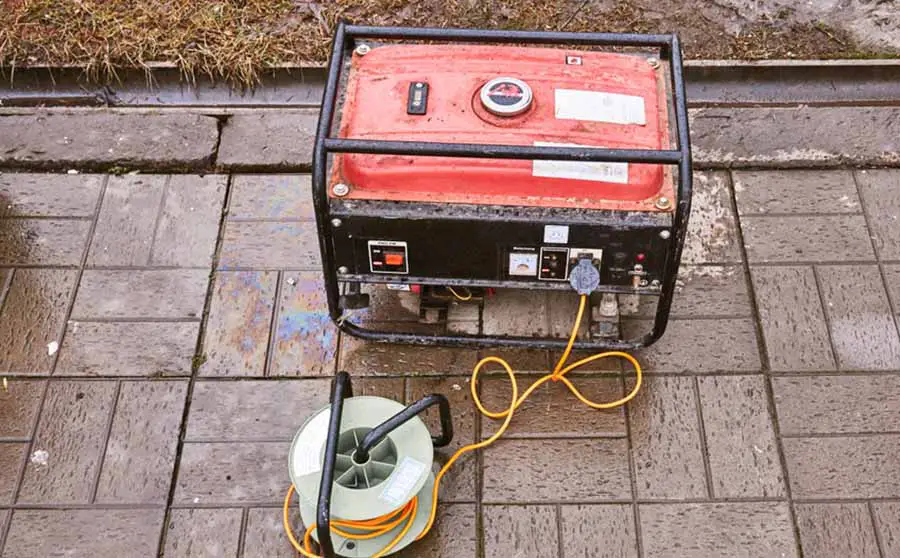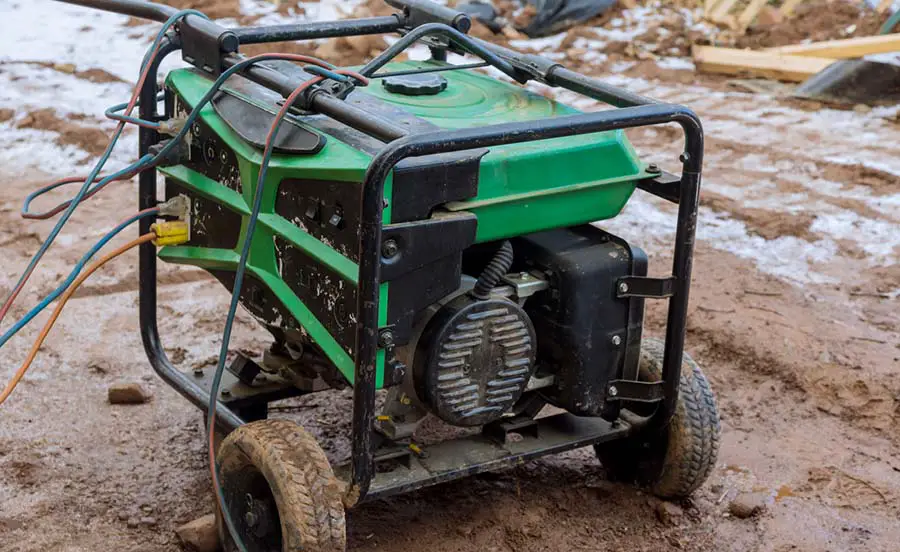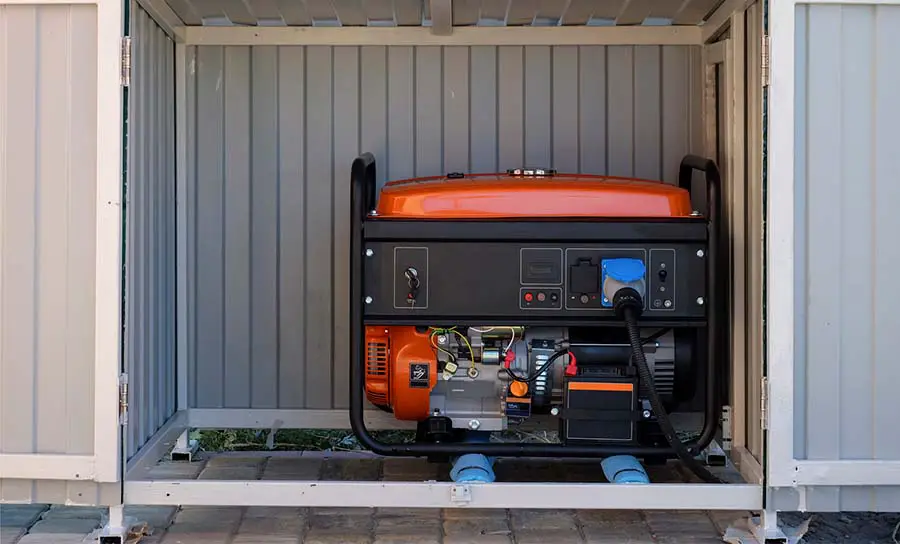
When it comes down to power outages, bad weather is one of the leading causes. Rain, storms, snowfall, and other harsh weather conditions often result in interrupted power supply to your home. When it’s raining outside and you lose power, you might be wondering whether or not you can use your generator.
Permanently installed standby generators have built-in covers that allow them to run while it’s raining. However, portable generators are not waterproof and must be run outdoors because of carbon monoxide fumes. To keep your generator dry, use a well-ventilated canopy, tent, or homemade cover.
In this article, we’ll break down everything you need to know about running a generator while it’s raining. From the risks associated with this to how you can safely run a generator in the rain, we’ll cover it all. Let’s get started!
How to Safely Run a Generator In the Rain
Manufacturers do not recommend running portable generators during these weather conditions due to the associated risks. For this reason, it’s important that you only attempt this when you have purchased a necessary, high-quality protective cover or enclosure for a running generator. We went through the different types of options that are available.
Keep reading as we take a look at the steps you need to take when running a portable generator while it’s raining outside!
1. Protect Your Portable Generator
The first step towards running your portable generator while it’s raining is to protect your generator. To do this, you’ll need to use a quality protective cover or enclosure, such as those we discussed in the previous section of this article.
You must take care to ensure that your chosen protective cover or enclosure meets all the necessary safety standards. The protective cover or enclosure you decide to get usually comes with instructions on setting it up in conjunction with your portable generator.
2. Consult the Owner’s Manual
Regardless of the weather conditions outside, you must always consult your owner’s manual before running your generator. Generally, the manufacturer of your portable generator will include a pre-start checklist that you should go through before running your generator.
3. Move the Portable Generator Outside
As mentioned earlier, you cannot use a portable generator indoors due to the risk of carbon monoxide poisoning. Furthermore, the placement of your generator outdoors is critical. You’ll want to place it at least 10 to 20 feet away from your property while also keeping neighboring homes in mind.
When placing your protected portable generator outside, you should avoid low garden areas where water pooling is a risk. To safely run your generator during rain, it not only needs to be protected, but you should place it on a dry and flat piece of land.
If you live in a region that regularly experiences rain, you may want to consider a permanent enclosure for your generator or upgrading to a whole house generator. Alternatively, pouring a concrete pad on your property can create a dry, flat surface for your protected generator to stand on while it is running in the rain.
4. Connect the Portable Generator to Your Appliances
When utilizing a portable generator, you’ll likely need a power cord to connect your appliances. When it’s raining, the safest extension cord option would be to use a grounded three-prong cord. This will protect you from electrical shock hazards while also preventing potential damage to your appliances.
5. Start Up Your Portable Generator
Once you’ve completed the above steps and have taken the appropriate measures to protect your generator from the rain, you’re ready to start it up! You’ll now be able to use your essential appliances while you wait for the rain to stop and the grid power to come back on.
The Risk of Running a Generator In the Rain

Apart from human error and routine maintenance, one of the leading causes of power outages are natural causes. Under this ‘natural causes’ umbrella, you’ll find conditions like storms, severe winds, ice, and snow.
While these conditions may be impossible to prevent, it can feel just as impossible to run a generator during these harsh climatic conditions. If this type of weather is to blame for your sudden power outage, you might be wondering how to proceed. If you need to run a generator in the rain, you’re likely utilizing a portable generator.
Permanently installed whole house generators have a built-in shelter that shields them from rain and other weather. With portable generators, on the other hand, placement is crucial. When the storm causes a power outage, you may be wondering whether or not you can simply bring the portable generator inside.
Of course, it is possible to store the portable generator inside while powered off. Manufacturers of portable generators always warn customers about the safety hazards of running these generators while they are inside. Doing this can lead to a buildup of carbon monoxide, which can be a serious safety hazard.
Manufacturers regularly stress the importance of utilizing portable generators outside. Even outdoors, the positioning of a portable generator is crucial. Your generator always needs to be at least twenty feet away from your home outside. You even need to consider neighboring properties when placing your generator outside for usage.
If you’re using a portable generator, you likely don’t use it every day. This means that it’s easy to overlook specific safety requirements, given you don’t use your generator frequently. However, in the last decade, there have been more than 700 fatalities linked to the use of generators.
Risks associated with running your generator while it’s raining:
- You have a higher chance of electrocution
- Water can short circuit or harm your generator
- A short sicruit can cause sparks and fires
Given that bad weather, such as rain, is one of the leading causes of a power outage, you may think that a portable generator is supposed to withstand this weather. That is a common misconception! Let’s take a look at the standard warnings you’ll find in the owner’s manual of a portable generator regarding using it while it rains.
The owner’s manual of your portable generator will dictate that the generator be kept dry. Using a generator in wet conditions could result in electrocution. This includes rain, snow, and even using the portable generator near a sprinkler system or pool.
Furthermore, storing or using your generator outside without the proper protective equipment can result in damage to your generator. That is because moisture, rain, and ice can cause your generator to short circuit or malfunction.
Now, you may be wondering about what exactly the proper protective equipment is for your generator. Keep reading as we take a look at this and how you can safely run your generator outside while it’s raining!
How to Protect Your Generator From the Rain

When it comes down to protecting your portable generator against the elements, it’s not enough to simply shelter it from the rain. You’ll need to prevent moisture from getting into the generator’s outlets actively. Luckily, there are plenty of great products available on the market to do just that!
Despite the advent of these protective products for your generator, using a portable generator in wet conditions is still discouraged by the manufacturers of these backup power supplies. Running a generator in the rain, therefore, is done at your own risk.
Before we take a look at some of the best protective options for your generator, let’s break down the requirements of a protective cover for a portable generator. Understanding these requirements will help you choose the best protective cover for running your generator in wet conditions.
Safety Requirements for a Portable Generator Cover
These are the safety standards a portable generator cover should meet to protect your generator from the rain adequately!
1. The Enclosure Can Withstand the Elements
This is one of the most important aspects of a protective cover or enclosure, especially if you’re looking to run your portable generator during adverse weather conditions, like rain and snow. You want to ensure that the cover you choose can withstand these harsh elements.
2. The Cover or Enclosure is Well-Ventilated
While running a portable generator in harsh weather conditions using a protective cover, the cover must maintain airflow. When your protective cover lacks the necessary ventilation, it can become a safety hazard due to the risk of the generator overheating.
3. The Enclosure Protects Against Moisture
Finally, the protective cover for your portable generator needs to protect it from moisture fully. Many parts of your generator are sensitive to moisture exposure, which could damage your generator and cause a safety hazard.
Given that bad weather is one of the leading causes of power outages, the potential for moisture in the air when you need to use your portable generator is excellent. Therefore, with any portable generator cover, you’ll need to ensure that your generator is 100% protected from the moisture in the air.
4. The Protective Cover is Portable
Portability is the last factor you need to consider when purchasing a protective cover for your generator. After all, when it comes down to portable generators, these generators need to be placed outside during usage. For this reason, you’ll want to get a protective cover that is just as portable as your generator. This will allow you to run your generator while it’s raining.
Types of Covers for Portable Generators
These are the different covers and enclosures that you can safely run your portable generator during wet weather conditions!
1. Standard Manufacturer Covers
When you purchase a portable manufacturer, it will likely come with a cover made from nylon. Typically, these covers meet the exact specifications of your specific model generator. However, these covers are usually meant to protect your portable generator during storage.
With this type of cover, you cannot use the cover while the generator is in use or is still hot. These covers designed by your generator’s manufacturer are specifically to keep the generator protected while it is off, has cooled down, and is in storage.
2. Protective Canopy Covers
A protective canopy is one of the easiest and most cost-efficient ways of protecting your portable generator while it is running. Elevated by poles, a canopy is an ideal form of protection against the elements as it does not touch your generator, enhancing airflow while protecting it.
However, there is usually strong wind when it rains. This means that the uncovered sides of the canopy could be insufficient in protecting your portable generator while it is raining. While it is possible to get a canopy with a walled side, it is always at risk of not being stable enough during harsh weather conditions.
3. Protective Tent Covers
Protective tent covers have become a popular choice for running their generators in wet weather conditions. These tent covers allow you to maintain your generator’s portability while providing the needed protection it requires to be used in the rain.
The right protective tent cover will protect your generator from rain and moisture while maintaining the necessary airflow to cool your running generator. Refueling your generator is also simple with these covers. GenTent offers universal tent covers for different types of portable generators.
4. Protective Steel/Aluminum/Fiberglass Enclosures
If you’re looking for a more rigid means of protecting your generator than a canopy or specialized tent, a protective steel enclosure may be the perfect option for you! There are many rigid enclosures designed to protect running generators. These enclosures are usually materials such as steel, aluminum, or fiberglass.
These rigid enclosures have the necessary vents to keep your portable generator running at optimal conditions, despite the less-than-optimal weather conditions outside. Many of these enclosures can even be locked, giving you an additional level of safety and security.
It’s no secret that generators can be loud! Another great benefit of a protective enclosure made from steel, aluminum, or fiberglass is that it reduces the noise produced by your generator while it is in use. There are many great, heavy-duty enclosures available for you to choose from!
5. Constructing Your Own Protective Enclosure
Finally, it is also possible to construct a protective enclosure yourself. However, you should not attempt this if you lack the required knowledge and skills. After all, we discussed the risks of running a generator in the rain earlier in this article.
If you decide to construct your own DIY portable generator enclosure, you must keep the requirements for this enclosure in mind. This means that your constructed enclosure needs to be portable, protect your generator against the elements, provide adequate airflow, and protect against moisture.
Suppose you’re looking to construct your own protective cover or enclosure for your portable generator. In that case, this YouTube video will guide you through the process, from the blueprint to your shopping list and the step-by-step instructions.
Conclusion
In this article, we explained everything you need to know about running your portable generator while it’s raining outside. First, we outlined the risks of using a portable generator while it’s raining – unless you have the proper protective cover, that is.
We then detailed the different covers and enclosures that you can use to operate your portable generator while it’s raining safely. Finally, we went through the process of setting up your portable generator outside while it’s still raining.

